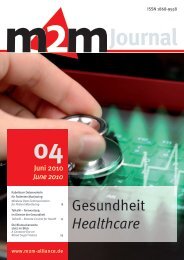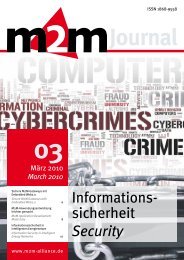M2M Summit 2011 Special Edition - M2M Alliance
M2M Summit 2011 Special Edition - M2M Alliance
M2M Summit 2011 Special Edition - M2M Alliance
Erfolgreiche ePaper selbst erstellen
Machen Sie aus Ihren PDF Publikationen ein blätterbares Flipbook mit unserer einzigartigen Google optimierten e-Paper Software.
Workshop Smart Grid, Smart Energy und Smart Metering<br />
Stromkunden nutzen flexible Stromtarife<br />
Consumers Use Flexible Energy Tariffs<br />
Lösungen zur Heimvernetzung und Hausautomatisierung sind auf dem Vormarsch.<br />
Ein großes Thema dabei ist die Interaktion von Geräten mit dem Energienetz der Zukunft<br />
– dem sogenannten Smart Grid.<br />
Home networking and automation solutions are on the rise and help consumers in<br />
their everyday lives. One major part of this trend is the interaction between appliances<br />
and the energy grid of the future, the so-called smart grid.<br />
Doch zahlen sich der Einsatz von Smart-<br />
Grid-fähigen Hausgeräten und die gezielte<br />
Nutzung günstiger Tarife tatsächlich<br />
aus? Die BSH Bosch und Siemens<br />
Hausgeräte GmbH und die E.ON Metering<br />
GmbH sind dieser Frage nachgegangen.<br />
Waschen und Spülen<br />
wenn es günstig ist<br />
Die Energielieferanten sind seit Anfang<br />
des Jahres dazu angehalten, dem Kunden<br />
variable Stromtarife anzubieten.<br />
Die Preisunterschiede der Tarife bilden<br />
das Kernkriterium, nach dem intelligente<br />
Hausgeräte künftig ihre Inbetriebnahme<br />
selbstständig steuern.<br />
In einer Studie von BSH E.ON mit 100 Teilnehmern<br />
wurde untersucht, inwieweit<br />
Verbraucher bereit sind, den Betrieb ih-<br />
30 <strong>M2M</strong> Journal 09 | <strong>M2M</strong> <strong>Summit</strong> – <strong>Special</strong> <strong>Edition</strong> | 09/11<br />
rer Geräte flexiblen Tarifen anzupassen.<br />
In einer ersten Phase wurde über einen<br />
Zeitraum von vier Wochen das „normale“<br />
Verhalten dokumentiert – das heißt ohne<br />
variable Tarife. Der eigentliche Feldversuch<br />
mit einem dynamischen Tarif erfolgte<br />
anschließend in einer zweiten Phase. Alle<br />
Haushalte wurden hierfür mit einem Apple<br />
iPod Touch ausgestattet, der über einen<br />
Zeitraum von rund sieben Wochen den aktuellen<br />
Stromtarif, eine Preis-Voraussage<br />
für die nächsten zwölf Stunden und eine<br />
Drei-Tages-Preisprognose anzeigte.<br />
Großes Potential<br />
in dynamischen Tarifen<br />
Die Auswertungen der Studie zeigen:<br />
Die Kunden sind bereit, ihr Verhalten<br />
dynamischen Stromtarifen anzupassen:<br />
50 Prozent aller Vorgänge wurden wäh-<br />
Die teilnehmenden Haushalte wurden vor<br />
Ort über die Studie und die Nutzung der<br />
iPODs informiert.<br />
Participating households received the<br />
information about study and right use of<br />
iPODs in their homes.<br />
rend der zweiten Phase verschoben.<br />
In Preisen ausgedrückt heißt das: Ab<br />
30 Cent / kWh wurde im Normalfall auf<br />
die Nutzung verzichtet. Lag die mögliche<br />
Ersparnis bei einer Preisdifferenz<br />
von 15 Cent / kWh oder mehr, wurde der<br />
Wasch- oder Spülvorgang nahezu immer<br />
verschoben. Im Vergleich zur Nutzung<br />
eines Standardtarifs ist auf Basis des<br />
genutzten Tarifmodells eine Kosteneinsparung<br />
von 25 Prozent möglich. Die<br />
Studie zeigt aber auch: Viele Verbraucher<br />
sind zwar stark am Thema Energiekosten<br />
interessiert, besitzen aber keine<br />
Detailkenntnisse über ihre Stromtarife,<br />
insbesondere hinsichtlich Preis pro kWh<br />
und Geräteverbrauch. Dementsprechend<br />
werden die Einsparbeträge einer flexiblen<br />
Stromnutzung von den Verbrauchern<br />
deutlich überschätzt.<br />
Gute Gründe für<br />
energieeffiziente Hausgeräte<br />
Eine wichtige Erkenntnis der Studie ist,<br />
dass die tatsächlichen Kosten und Verbrauchsvolumina<br />
der Geräte künftig<br />
transparenter dargestellt werden müssen.<br />
Bei kommenden Gerätegenerationen<br />
werden deshalb verstärkt die Trends<br />
der Energiewirtschaft berücksichtigt.<br />
Since smart grid-capable home appliances<br />
can save money by taking advantage<br />
of reduced electricity rates (such as<br />
night rates).<br />
Doing the laundry and washing<br />
dishes when rates are low<br />
Since the beginning of this year, energy<br />
utilities are obliged to offer consumers<br />
variable power tariffs. It is these price<br />
differences that will form the core criterion<br />
by which smart home appliances<br />
will control their own operation in the future<br />
– if individual end users want to use<br />
this feature. With E.ON Metering GmbH<br />
BSH conducted a study in the first quarter<br />
of <strong>2011</strong> on smart homes and dynamic<br />
electricity tariffs. The companies analyzed<br />
how many end users would be willing<br />
to adapt the operation of their appliances<br />
to flexible electricity rates. 100<br />
German households participated in the<br />
study. During an initial four-week phase<br />
of the study, the “normal” consumption<br />
behaviour of the participants – that is,<br />
without variable electricity tariffs – was<br />
documented. The actual field phase,<br />
with the dynamic tariff, took place in a<br />
second phase immediately thereafter.<br />
For this part of the trial, all the households<br />
were provided with an Apple iPod<br />
Touch which, for a period of around six<br />
weeks, displayed the current electricity<br />
tariff, a price prediction for the next<br />
twelve hours and a price forecast for the<br />
next three days.<br />
High saving potential<br />
in flexible energy tariffs<br />
The results proved that customers are<br />
willing to adapt their behavior to variable<br />
electricity tariffs: in the second<br />
phase they moved 50 percent of all activities<br />
to lower-cost periods. If savings<br />
reached 15 cents per kWh or more, they<br />
moved running the washing machine or<br />
the dishwasher to a lower-cost period al-<br />
Workshop Smart Grid, Smart Energy und Smart Metering<br />
Über einen iPOD Touch<br />
wurden die flexiblen<br />
Strompreise dargestellt<br />
– in diesem Beispiel die<br />
3-Tages-Prognose.<br />
Via an iPOD Touch the<br />
dynamic electricity tariffs<br />
were shown – this example<br />
shows the 3-day-forecast.<br />
most every time. By doing this, savings of<br />
25 percent are possible compared to the<br />
standard tariff. The study also showed<br />
that many consumers are very interested<br />
in energy costs, but have no detailed<br />
knowledge of electricity tariffs, particularly<br />
in terms of price per kWh and the efficiency<br />
of their appliances.<br />
Good reasons for energy efficient<br />
household appliances<br />
“For future appliance generations we<br />
will increasingly take the trends in the<br />
utility industry into account,” says Dr.<br />
Claudia Häpp. “As soon as the market<br />
indicates a demand for appliances that<br />
can communicate with the smart grid using<br />
standardized technologies, we will<br />
have matching solutions in our portfolio.<br />
Nevertheless, the energy efficiency of appliances<br />
continues to be a much more effective<br />
lever in our quest for real resource<br />
savings.”<br />
Contact<br />
Dr. Claudia Häpp<br />
Projektleitung<br />
Home Connect / Smart Grid<br />
BSH Bosch und<br />
Siemens Hausgeräte GmbH<br />
Claudia.haepp@bshg.com<br />
www.bsh-group.de<br />
<strong>M2M</strong> Journal 09 | <strong>M2M</strong> <strong>Summit</strong> – <strong>Special</strong> <strong>Edition</strong> | 09/11 31






